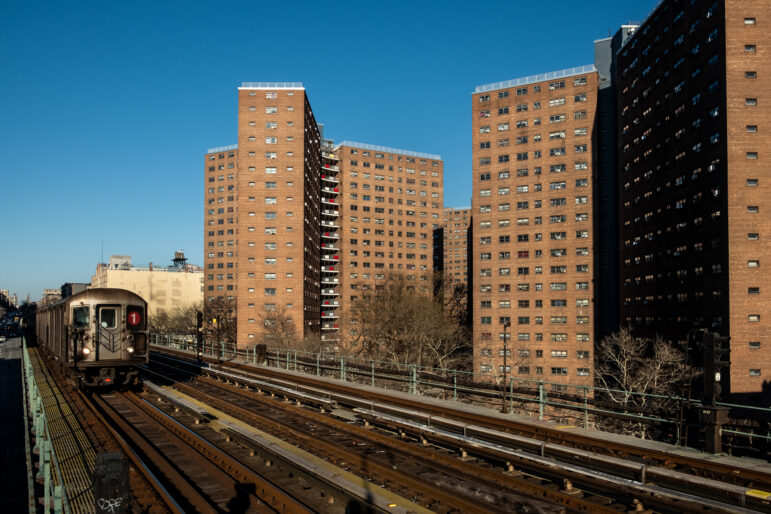
Tenants, Lawmakers and Advocates Weigh In As NYCHA’s ‘PACT’ Plan Progresses
To date, 37,707 NYCHA units are either in the planning and engagement stage, under construction or have already been converted to the Permanent Affordability Commitment Together (PACT) initiative, officials testified at a recent City Council hearing.
Adi Talwar
NYCHA’s Manhattanville Houses in Harlem is among the public housing campuses that have been converted to the PACT program.
During a recent City Council hearing, the New York City Housing Authority (NYCHA) testified that an “incredibly impactful initiative” is bringing in billions of needed dollars to help restore and repair its aging properties.
The initiative referenced was the Permanent Affordability Commitment Together (PACT) program—which converts public housing properties, also known as Section 9, to the federal Section 8 program as a means to unlock additional repair funds. To date, 37,707 NYCHA units are either in the planning and engagement stage, under construction or have already been converted.
As part of the process, NYCHA campuses are turned over to private developers to carry out renovations such as new windows, kitchens, bathrooms and building facades. The new management team also handles the day-to-day operations, while NYCHA continues to own the land.
“Right now, 57 developments are under active construction, representing over $3.9 billion in construction work happening across the city—work that we would not be able to accomplish without PACT considering the lack of federal capital funding available,” Jonathan Gouveia, NYCHA’s executive vice president for real estate development, testified to councilmembers at the April 19 hearing.
NYCHA presented a survey of PACT tenants which showed that 77 percent of respondents were “very satisfied” with renovations to their buildings, 87 percent said they were “likely or very likely” to recommend the PACT program to other NYCHA developments, 78 percent said the grounds were more kempt than before, and close to 70 percent said they feel “more stable” than prior to the conversion.
But some tenants who testified at the Committee on Public Housing hearing painted a different picture. They shared concerns such as getting timely repairs post-conversion, and questioned NYCHA’s process for selecting the campuses it converts to PACT. Councilmembers also had a plethora of questions.
Councilmember Alexa Aviles, the former chair for the public housing committee, asked officials about tenant participation in the survey results they shared, which included responses from residents at just four PACT-converted developments, out of the 138 that are currently under the program or in the process of converting.
Gouveia shared that roughly 1,000 residents from the four developments replied to the survey. It is unclear how many tenants responded from each campus.
“I would love for you to provide for the Council what that breakdown actually looks like,” Aviles said.
Repairs and rights
PACT is New York City’s version of the U.S. Department of Housing and Urban Development’s Rental Assistance Demonstration (RAD) program, introduced in 2011. NYCHA developments that convert are also referred to as RAD-PACT properties.
It is one of the programs—alongside the newer Public Housing Preservation Trust—being used to help chip away at the near $80 billion the housing authority says it needs over the next two decades for capital repairs.
When NYCHA tenants have maintenance issues, there are a couple of ways to flag them. Public housing tenants can either call the Customer Contact Center (CCC) or submit a ticket or work order online, where they can track the status of the request.
When a development is transferred to PACT, the new private management team takes over repairs at a development. But the housing authority is responsible for maintenance repairs up until the date of conversion—which can take about two years, according to advocates—potentially leaving tenants in a period of limbo.
Alexandra MacDougall, a staff attorney at the Legal Aid Society, testified about concerns she has heard from clients who live in PACT developments post-conversion.
While NYCHA receives frequent criticism for how it handles repairs and the pace of making fixes—it took the Housing Authority an average of 370 days to complete repair work in March, when the target is 15 days—residents are at least able to track the status of their work order requests online.
There is no such uniform system for tenants to place work orders at PACT-converted campuses, advocates noted.
“A lot of tenants tell us there’s not really a clear way to make requests for repairs and to track those requests which is a huge problem,” MacDougall said. “Especially after hours in the evenings and on the weekends when there’s serious issues like boilers going out.”
August Leinbach, a staff attorney at the Manhattan Housing Unit of Legal Services NYC, said tenants they’ve worked with have continued to live in poor conditions post-conversion despite the promise of rehabilitation.
“While the central promise of the RAD-PACT program has… [been] to fund repairs for rehabilitation, this promise often comes slowly, if at all,” said Leinbach.
Different PACT partners use their own tracking software for repairs and are supposed to provide NYCHA with a summary of that data, according to Gouveia. According to NYCHA’s “PACT Project Progress and Compliance Oversight” dashboard, 93 percent of work orders submitted by PACT residents were completed on time as of the third quarter of 2023.
“We track work orders and resolutions of work orders on a monthly basis and overall the performance is strong, well over 90 percent on time,” said Gouveia.
“However, as we’ve heard, sometimes that doesn’t seem to be the case so I would invite the residents to obviously work with their property managers,” he added. “But also if they’re not getting satisfactory answers, they can reach out to us through the PACT hotline, through CCC, through 311, but primarily through us and we’ll look into the issue.”
Which developments get PACT?
In December 2018, NYCHA set a goal to convert 62,000 of its properties to the PACT program by 2028, according to Gouveia. The housing authority has surpassed the halfway mark with more than 37,000 converted units, or units in the process of converting.
NYCHA developments are considered for PACT based on several factors, he said, including the level of deterioration determined by NYCHA’s Physical Needs Assessment (PNA) and the overall quality of maintenance on a day to day basis.
For prospective PACT developments, NYCHA said that the team works with resident leadership and will then have meetings with the development at large to determine if the program is a fit.
One East New York tenant who only wanted to go by the name “Miss Yves” said that she is living in a PACT development, the Penn-Wortman Houses, which was converted in 2021.
“We didn’t have a choice to vote,” she said.
Brian Honan, the senior vice president of NYCHA’s office of intergovernmental relations, said that the housing authority has no interest in forcing the program onto residents who don’t want it.
“The federal law does not require a percentage of residents to support a PACT project for conversion, however, we have engaged residents at certain sites and they told us they are not interested,” Honan said.
Last year, the housing authority introduced an election process for the first time, by which residents at selected campuses who are over the age of 18 and are on the household composition—a list of authorized tenants who live in the unit—can vote on the future of their homes.
On the ballot is PACT and another funding model called the Public Housing Preservation Trust, signed into law by Gov. Kathy Hochul in 2022. Under the Trust model, properties will also convert to Section 8 and can unlock funds through bonds for repairs (NYCHA would continue to manage the properties, rather than bringing in private companies, as PACT does.) Residents can also vote to remain in traditional Section 9 public housing.
So far, two developments—Nostrand Houses in Brooklyn and Bronx River Addition Houses—have been allowed to vote on which model they want, and voters at both opted for the Trust.
Other ways of getting tenant input have been introduced, but also faced skepticism. Last year, residents of the Fulton Elliott-Chelsea Houses in lower Manhattan were given a survey to determine whether their properties should get traditional PACT renovations or start from scratch by way of razing the existing buildings and constructing new towers.
NYCHA announced that a majority of participating residents opted for demolition, but questions arose about how the options were presented, how many tenants participated and whether the survey was an accurate representation of what the majority of residents want.
Ramona Ferreyra, a resident of Mitchel Houses in the Bronx, testified as a member of the group Save Section 9, which is fighting to keep units in the traditional public housing program and to see Section 9 funded adequately without shifting units to private management or the Trust.
“What you’ll know today is that the tenants are telling you that in spite of the tenant repairs that we need, what we want is to keep public housing,” Ferreyra said.
To reach the reporter behind this story, contact Tatyana@citylimits.org. To reach the editor, contact Jeanmarie@citylimits.org
Want to republish this story? Find City Limits’ reprint policy here.
The post Tenants, Lawmakers and Advocates Weigh In As NYCHA’s ‘PACT’ Plan Progresses appeared first on City Limits.


